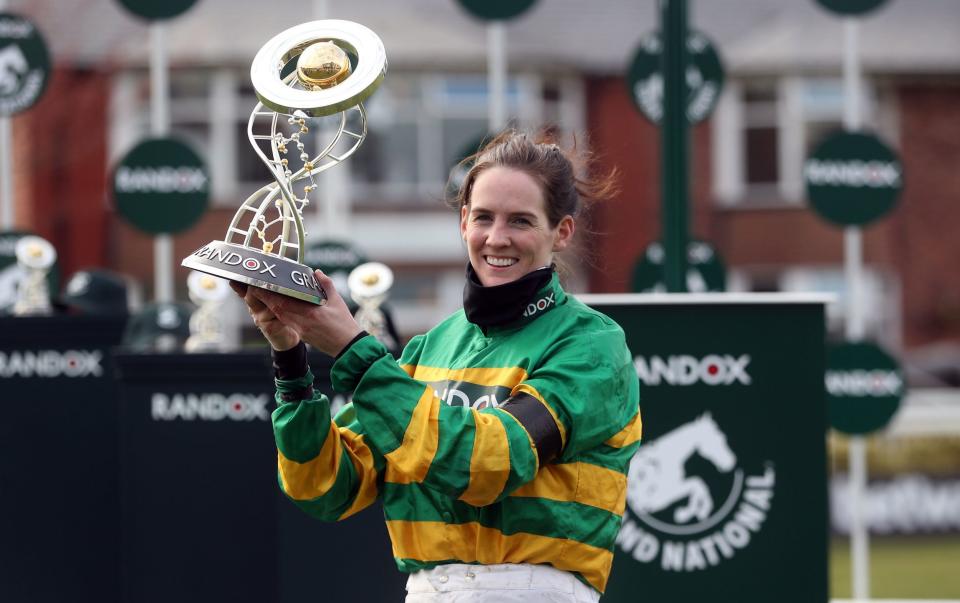Sportswomen of the year: Rachael Blackmore's historic triumph lifts racing from the doldrums

In March and April, as racing sought to get over the image of Gordon Elliott sitting on a dead horse and the Cheltenham Festival nervously prepared to race behind closed doors having borne the brunt of the blame for the coronavirus pandemic a year earlier, Rachael Blackmore rode to the sport’s rescue.
She took Cheltenham by storm, winning the Champion Hurdle on Honeysuckle and the Ruby Walsh Trophy for leading jockey with six winners. Then, in April, she and Minella Times won the Grand National – a feat once so far-fetched for a woman jockey that it had only been achieved by a female in fiction. Overnight, the farmer’s daughter from Tipperary went global.
Ed Chamberlin, the host of ITV Racing, says he has a great deal for which to thank Blackmore. “It was so gloomy going into Cheltenham,” he recalls, “and Honeysuckle changed it in an instant. I remember going into a break after she had ridden five winners saying: ‘Blackmore five, Britain four.’
“You left Cheltenham daring to dream that she had a chance of doing the impossible. Des Lynam was my hero. His Grand National interviews stick in my mind and the moment I’ll treasure for evermore was when she said: ‘I can’t believe I’m Rachael Blackmore.’ That’s her in a nutshell; self-deprecating, engaging, charming but, at the same time, with this incredible will to win and with ice in her veins.”
Blackmore’s first chance in racing came from trainer “Shark” Hanlon when she was an amateur and – it appeared from the results at any rate – an average one at that. Unlike many of her weighing-room colleagues, however, she had back-up in the form of a degree in equine science from Limerick University so, to some extent, a comfort blanket if things did not work out.
Turning professional was, nevertheless, an “unusual course” but, in typical Blackmore fashion, when people questioned it, it would only spur her on.
Hanlon’s bigger concern was that she was riding too many bad, unschooled horses in point-to-points, so it was he who persuaded her to turn professional.
“I said ‘give it six or seven months as a conditional jockey and you can always turn back to amateur if you’re not happy,’ ” Hanlon recalls.
“I suppose the first thing I spotted in her was that she was a great girl to get a horse to jump a fence. She got horses to jump better than anyone else. She had a great eye for a fence and was a great worker. She was a great trier – no matter what horse you put her on she’d try on it and usually without too many instructions.”
Blackmore, 32, shares a house with her boyfriend, fellow jockey Brian Hayes, and the most successful amateur jockey in Irish racing history, Patrick Mullins. “There are a couple of technical things that she’s very good at,” observes Mullins, who rides against her. “She’s very good into a fence so horses jump well for her and she’s very good at getting horses to settle. She’s 9st so it just goes to prove it’s not about strength. She settles them by letting them go forward rather than holding and fighting them.
“On the ground she is very good at dealing with people. If there’s a disagreement, say with an owner or trainer, about what went on in a race, she is very diplomatic, which is a very underrated quality in my book. Ruby Walsh had that.
“The other thing is that she got her success relatively late on. I think that’s a massive advantage. She doesn’t take anything for granted and she understands the value of hard work, showing up and being there.”
The winning ride in the National is always a good one, but Blackmore’s was perfection; she rarely left the inside – the one time she did she avoided the fall, broadside on, of Double Shuffle – she got Minella Times into a superb rhythm with his jumping, and she always seemed to have a pocket of space around her. She made what was once considered the impossible look easy.

“I suppose women had been knocking on the door of the National for 10 years,” says Katie Walsh, a now retired fellow Irish jockey who finished third on Seabass in 2012.
“When Rachael came on the scene, if she got a proper spin in the race, I thought it could happen and I’m delighted it was her. She takes the ups with the downs, has a racing brain and knew she’d have to graft and she did. I was lucky to be at Aintree, but I felt being there I was witnessing history – there weren’t many there, but it brought the house down. You see the response she gets now on the back of Cheltenham and Aintree. Everyone wants to be on her team.”
Winning the National has not changed Blackmore. She has always preferred to let her riding do the talking and that remains the case. Ironically, while it could have been racing’s Emma Raducanu moment, with the jockey splashed across the newspapers for a fortnight, Blackmore opted out of most interviews and commercial contracts. The day after the National, as the world’s media chased her, she was uncontactable. Instead, she opted to do what Eddie Jones controversially advocated for Raducanu: keep your head down, avoid the trappings of fame and concentrate on the job. That policy has paid dividends for her.
While it is fair to say Raducanu’s career has been patchy since her US Open victory, even after three months out with a broken ankle, Blackmore returned as if she had not missed a day and the big winners are rolling in again, most notably the victory of A Plus Tard in the Betfair Chase at Haydock in November.
She has finished the year as she began it.

 Yahoo Sport
Yahoo Sport 





































